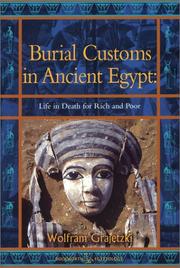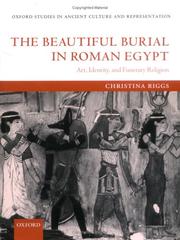| Listing 1 - 7 of 7 |
Sort by
|

ISBN: 0715632175 9780715632178 Year: 2003 Publisher: London: Duckworth,
Abstract | Keywords | Export | Availability | Bookmark
 Loading...
Loading...Choose an application
- Reference Manager
- EndNote
- RefWorks (Direct export to RefWorks)
The pyramids of Gizeh and the tomb of Tutankhamun are two examples of the legendary energy that the Ancient Egyptians devoted to their tombs. But it was not only the rich who had pyramids as this work shows, giving a broad picture of burial as practiced throughout society over the millennia.
Burial --- Egyptians --- Tombs --- Excavations (Archaeology) --- Funeral customs and rites --- Egypt --- Antiquities --- Burial - Egypt --- Egyptians - Funeral customs and rites --- Tombs - Egypt --- Excavations (Archaeology) - Egypt --- Egypt - Antiquities
Book
ISBN: 294001101X 9782940011018 Year: 1993 Volume: 2 Publisher: Genève: Société d'égyptologie,
Abstract | Keywords | Export | Availability | Bookmark
 Loading...
Loading...Choose an application
- Reference Manager
- EndNote
- RefWorks (Direct export to RefWorks)
Burial --- Fertility --- Figurines --- Birth customs --- Religious aspects --- History --- Burial - Egypt - Religious aspects --- Fertility - Egypt - History --- Figurines - Egypt --- Birth customs - Egypt - History
Book
ISSN: 03406342 ISBN: 9783447068727 3447068728 Year: 2013 Volume: 54 Publisher: Wiesbaden: Harrassowitz,
Abstract | Keywords | Export | Availability | Bookmark
 Loading...
Loading...Choose an application
- Reference Manager
- EndNote
- RefWorks (Direct export to RefWorks)
Tombs --- Burial --- Egypt --- Antiquities --- Antiquities. --- Conferences - Meetings --- Mastabas --- Burial customs --- Burying-grounds --- Graves --- Interment --- Archaeology --- Public health --- Coffins --- Dead --- Funeral rites and ceremonies --- Grave digging --- Tombs - Egypt --- Burial - Egypt --- Egypt - Antiquities

ISBN: 1280758163 0191534870 1429430907 9781429430906 019927665X 9780199276653 9780191534874 9781280758164 1383042055 Year: 2005 Publisher: Oxford New York Oxford University Press
Abstract | Keywords | Export | Availability | Bookmark
 Loading...
Loading...Choose an application
- Reference Manager
- EndNote
- RefWorks (Direct export to RefWorks)
Looking at the intersection of Greek and Egyptian art forms in the funerary sphere of Roman Egypt, this work presents a discussion of artistic change, cultural identity, and religious belief.
Funeral rites and ceremonies --- Burial --- Art, Egyptian. --- Romans --- Egyptian art --- Burial customs --- Burying-grounds --- Graves --- Interment --- Archaeology --- Public health --- Coffins --- Dead --- Grave digging --- History --- Egypt --- Civilization --- Art, Egyptian --- Art, classical --- Sépulture --- Art antique --- Histoire --- Greek influences. --- To 1500 --- 332 B.C.-638 A.D. --- Funeral rites and ceremonies - Egypt. --- Burial - Egypt - History - To 1500. --- Romans - Egypt. --- Funeral rites and ceremonies - Egypt --- Burial - Egypt - History - To 1500 --- Romans - Egypt --- Art, Classical
Book
ISBN: 3927552011 9783927552012 Year: 1990 Volume: 1 Publisher: Heidelberg: Heidelberger Orientverlag,
Abstract | Keywords | Export | Availability | Bookmark
 Loading...
Loading...Choose an application
- Reference Manager
- EndNote
- RefWorks (Direct export to RefWorks)
Funeral rites and ceremonies --- Excavations (Archaeology) --- Funérailles --- Fouilles (Archéologie) --- Rites et cérémonies --- Egypt --- Egypte --- Antiquities --- Antiquités --- Burial --- Tombs --- -Tombs --- -Egypt --- -Burial customs --- Burying-grounds --- Graves --- Interment --- Archaeology --- Public health --- Coffins --- Dead --- Grave digging --- Civilization --- -Burial --- -Civilization --- -Funeral rites and ceremonies --- Funérailles --- Fouilles (Archéologie) --- Rites et cérémonies --- Antiquités --- Mastabas --- Burial customs --- Burial - Egypt. --- Tombs - Egypt.
Book
ISBN: 0812245679 1322512930 0812209192 9780812245677 Year: 2014 Publisher: Philadelphia: University of Pennsylvania press,
Abstract | Keywords | Export | Availability | Bookmark
 Loading...
Loading...Choose an application
- Reference Manager
- EndNote
- RefWorks (Direct export to RefWorks)
During the late Middle Kingdom (about 1850-1700 B.C.E.), ancient Egyptian women of high standing were interred with lavish ornamentation and carefully gathered possessions. Buried near the pyramids of kings, women with royal connections or great wealth and status were surrounded by fine pottery and vessels for sacred oils, bedecked with gold and precious stones, and honored with royal insignia and marks of Osiris. Their funerary possessions include jewelry imported from other ancient lands and gold-handled daggers and claspless jewelry made only to be worn in the tomb. Extensively illustrated with archival images and the author's own drawings, Tomb Treasures of the Late Middle Kingdom describes and compares the opulent tombs of eminent and royal women. In addition to the ornaments, many of which are considered masterpieces of Middle Kingdom craft, Egyptologist Wolfram Grajetzki examines the numerous grave goods, artifacts of daily life, and markers of social status that were also placed in tombs, presenting a more complete picture of funerary customs in this period. By considering celebrated examples of female burials together for the first time, Tomb Treasures of the Late Middle Kingdom sheds new light on the role and status of women in the royal court and explores how the gendered identity of those women was preserved in the grave.
Egyptians --- Sépulture --- Egyptiens --- Funeral customs and rites --- Funeral customs and rites. --- Burial --- Excavations (Archaeology) --- Tombs --- Women --- Human females --- Wimmin --- Woman --- Womon --- Womyn --- Females --- Human beings --- Femininity --- Mastabas --- Ethnology --- Burial customs --- Burying-grounds --- Graves --- Interment --- Archaeology --- Public health --- Coffins --- Dead --- Funeral rites and ceremonies --- Grave digging --- History --- Egypt --- Antiquities. --- Civilization --- Antiquities --- Tombeaux --- Sépulture --- Femmes --- Fouilles (Archéologie) --- Rites and ceremonies --- Histoire --- Rites et cérémonies --- Egypte --- Civilisation --- Antiquités --- Tombs - Egypt --- Burial - Egypt --- Women - Egypt - History - To 500 --- Egyptians - Funeral customs and rites --- Excavations (Archaeology) - Egypt --- Egypt - Civilization - To 332 B.C. --- Egypt - Antiquities --- Ancient Studies. --- Archaeology.
Book
ISBN: 2356681868 2356680586 9782356680587 Year: 2016 Publisher: Lyon: Maison de l'Orient et de la Méditerranée - Jean Pouilloux,
Abstract | Keywords | Export | Availability | Bookmark
 Loading...
Loading...Choose an application
- Reference Manager
- EndNote
- RefWorks (Direct export to RefWorks)
En Égypte ancienne, la mort semble être une préoccupation constante. Pour affronter cette étape tant redoutée, le dogme prévoit une existence dans l'au-delà, mais celle-ci demeure conditionnée au maintien de la mémoire des individus parmis les vivants. Chaque personne va donc tenter, en fonction de son statut et de ses capacités, de développer certaines stratégies pour rendre son propre culte éternel et garantir ainsi son immortalité. Cette étude, fondée principalement sur l'analyse des pratiques post-inhumatoires, souhaite mettre en évidence les différents leviers qui sont utilisés en vue de pérenniser les cultes mémoriels : le choix du lieu, celui des supports et enfin - peut-être surtout - l'intégration à de multiples matrices sociales complémentaires. Car le maintien de la mémoire est avant tout affaire de société. L'individu, pour exister, se doit d'interagir avec la communauté, qu'il soit vivant ou bien mort.
Funeral rites and ceremonies, Ancient - Egypt
---
Burial - Egypt - History - To 332 B.C.
---
Tombs - Egypt
---
Excavations (Archaeology) - Egypt.
---
Egypt - Antiquities
---
Classics
---
History
---
nécropole
---
mémoire
---
saint
---
élite
---
piété
---
tombe
---
culte
---
rite funéraire
---
offrande
---
libation
---
dévotion
---
divination
---
sectorisation
---
matrice sociale
---
valorisation
---
stratégie
---
dédicace
---
Egypt
---
Egypt.
---
Ägypten
---
Antiquities.
---
Miṣr
---
Chibet
---
Ghubt
---
Ghibt
---
Arabische Republik Ägypten
---
Dschumhūriyyat Misr al-ʿarabiyya
---
República Árabe de Egipto
---
Ŷumhūriyyat Miṣr Al-ʿArabiyyah
---
Arab Republic of Egypt
---
Ǧumhūriyyat Miṣr al-ʿArabiyyah
---
Arabiese Republiek Egipte
---
République arabe d'Égypte
---
Jumhuriyyat Miṣr al-ʿArabiyyah
---
Repubblica Araba d'Egitto
---
Egyiptomi Arab Köztársaság
---
Mısır Arap Cumhuriyeti
---
Ǧumhūrīyat Miṣr al-ʿArabīya
---
ARE
---
Egypte
---
<
| Listing 1 - 7 of 7 |
Sort by
|

 Search
Search Feedback
Feedback About UniCat
About UniCat  Help
Help News
News